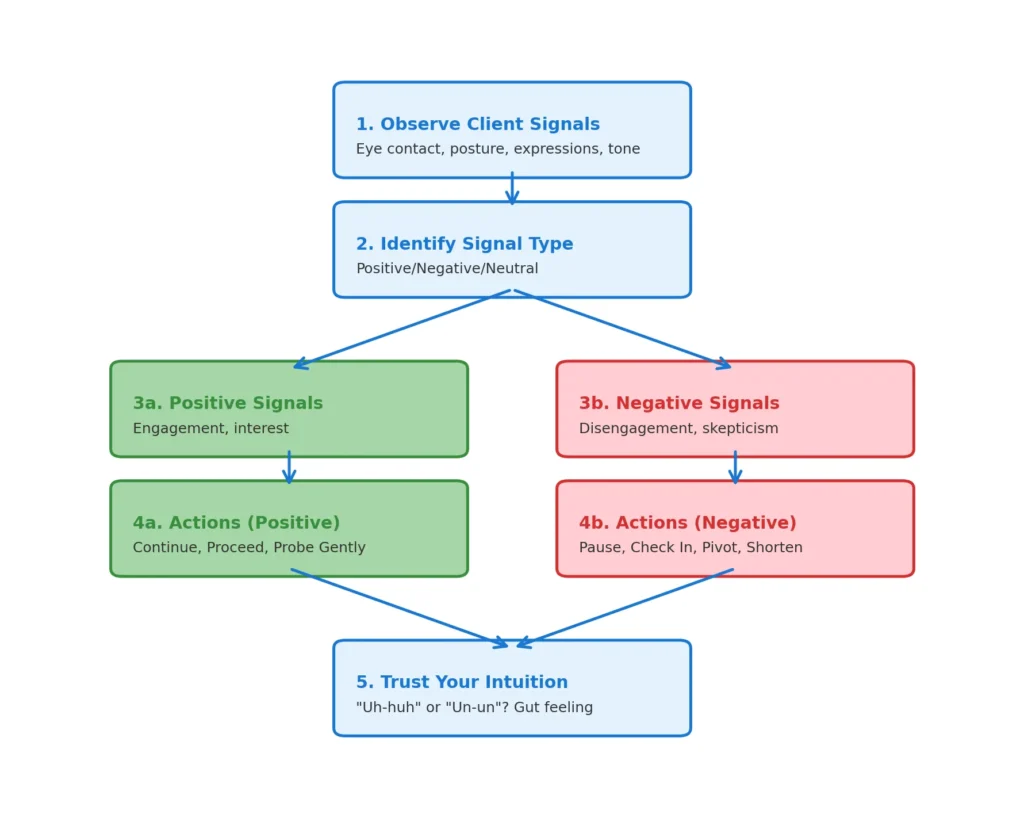Understanding body language, facial expressions, and tone is a vital layer of communication. For you, this is a key part of receiving the “response” you are waiting for and trusting your intuition throughout the client engagement flow. Paying attention to these signals demonstrates Respect and helps maintain Safety by ensuring you are attuned to the client’s comfort level and true feelings.
Here are some common non-verbal signals and how to interpret them:
Positive / Engagement Signals (Likely an “Uh-Huh” or Openness):
These signals suggest the client is interested, comfortable, and engaged with the conversation.
- Eye Contact: Consistent, direct eye contact (but not an unblinking stare). They look at you when you’re speaking and maintain contact when they are speaking.
- Body Posture: Leaning slightly forward, open posture (arms uncrossed, legs uncrossed), relaxed shoulders. They are oriented towards you.
- Facial Expressions: Smiling (genuine smiles that reach the eyes), nodding in agreement or understanding, eyebrows slightly raised (showing interest or curiosity). Their expressions mirror yours naturally.
- Gestures: Open hand gestures, comfortable stillness, occasional affirmative nods.
- Tone of Voice: Warm, modulated, engaged, asking questions enthusiastically or thoughtfully.
What to do:
- Continue: If you’re in a listening phase (Step 3, 4), keep encouraging them to share.
- Proceed: If you’ve just asked a “checking in” question (Step 2) or are exploring solutions (Step 5), positive non-verbals are a green light to continue on that path.
- Probe Gently: If they seem particularly engaged by a topic, you can gently ask for more detail: “You seemed to react to that point, can you tell me more about it?”
Negative / Disengagement / Skepticism Signals (Likely an “Un-Un” or Resistance):
These signals suggest the client is uninterested, uncomfortable, skeptical, or closed off. Pay extra attention if these contradict positive verbal responses.
- Eye Contact: Avoiding eye contact, looking away frequently, staring at the clock or out the window, excessive blinking, narrowed or squinting eyes (skepticism).
- Body Posture: Leaning back significantly, crossed arms or legs, slumped shoulders, physically turning their body away from you, fidgeting excessively (tapping fingers, shaking leg).
- Facial Expressions: Frowning, tight lips, forced or minimal smile, single raised eyebrow (skepticism or disbelief), blank or bored stare.
- Gestures: Closed hand gestures (fists), defensive arm positions (across chest), using objects as barriers.
- Tone of Voice: Flat, monotone, short or clipped answers, sighing, sounds of impatience, overly polite but lacking warmth.
What to do:
- Pause and Re-Evaluate: Recognize this as a signal that something isn’t resonating. Don’t ignore it, even if their words are polite.
- Check In Verbally (Gently): Ask a low-pressure question to give them a chance to voice their discomfort or lack of interest. “I sense I might be going into too much detail here, would you prefer I focus on a different aspect?” or “How does this feel to you so far?”
- Pivot: Change the topic or approach. If they seem bored with details, pivot back to the big picture impact. If they seem skeptical, pivot to social proof (if appropriate and earned) or offer to explore their specific concern.
- Shorten or End: If negative signals persist, particularly after attempting to re-engage, it might be a signal that they are not ready, not interested, or you are not the right fit at this time. Respect their signals and gracefully shorten the conversation or move towards a low-pressure conclusion (“Navigating ‘No'”). Pushing against these signals will likely lead to frustration (your Not-Self) and damage the relationship.

Trusting Your Intuition:
Interpreting reactions isn’t a rigid science. It’s an input for your intuition. Pay attention to the overall feeling you get from their non-verbals combined with their words. Does it feel like an “uh-huh” of genuine connection and interest, or an “un-un” of resistance or misalignment? Trust that gut feeling – it integrates these complex signals for you.
If this post is resonating with you, keep reading — the posts below could help you take the next step.
10 Skeptical, Challenging Questions
Interactive RSTC Presentation
RSTC Method Slide Deck Chief Cook and Bottle Washer Building Strong Client Partnerships: Respect, Safety,…
Building Strong Client Partnerships: The RSTC Method
Introduction: Building Our Special Client Tower! (3 min) Speaker Notes: Imagine we’re building a big,…
1.Introducing Myself to a Client Approach
This introduction blends your professional background with your natural, responsive, and practical approach, subtly laying…
Building a Trusted Partnership – A Consultative Flow
My approach to engaging with potential clients is inspired by the idea of structured steps,…
2.RSTC Method (Respect-Safety-Trust-Client)
Building Successful Partnerships: My Approach to Client Relationships In the complex world of IT and…

